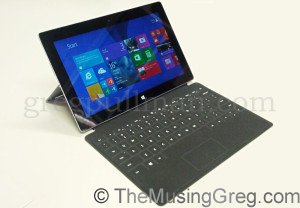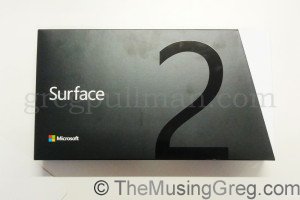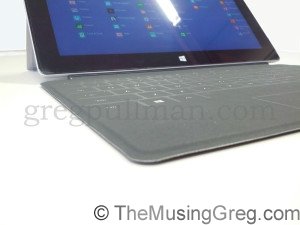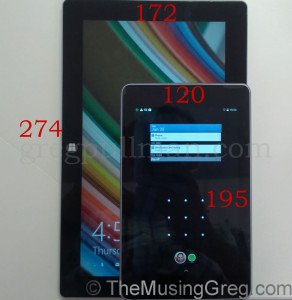I went against popular wisdom and bought the Surface 2 with the Touch cover. And so far, I’m pretty happy with it. If this surprises you, read on.
Background

I’m a Health and Safety Officer, and while I’m at my desk a lot of the time I’m sometimes in the field doing safety inspections and risk assessments, or in meetings (as a participant or convenor). For the past few years I’ve used my personal HP Touchpad and more recently my Nexus 7 for this, but I bought these for my personal use, not for work, and so for various reasons weren’t ideal for work purposes. The biggest thing I find I need when away from my desk is a solid MS Office suite, and both these devices were lacking in that department.
Back in the day, I had a Palm Treo 750 running Windows Mobile 6 and its provision of a mobile Office suite was one reason this was a winner device for me. For this reason the original line of Surface products looked impressive, especially as I’m a big fan of a physical keyboard. But the version 1 products didn’t quite cut it for me; I liked the Surface Pro concept, but not the battery life. I liked the Surface weight, but not the single position kickstand. So I thought I’d wait until Surface 2 came along and reassess. Since it hit the shelves there’ve been a few other hybrid devices, some rocking Bay Trail chips with full fat Windows 8.1. These sounded promising, but ultimately the hardware seemed to lack the premium edge of the Surface; plus I like a clean vanilla operating system without bloatware (which is why my personal phone and tablet are both Nexus devices), so I was back choosing between the Surface 2 or the Surface 2 Pro.
Decision Time
For me, this is how the factors stacked up:
| Surface 2 Advantages | Surface 2 Pro advantages |
|---|---|
Desk work:
Mobile work / convenience:
|
Desk work:
Mobile work / convenience:
|

Many reviews seem to tout the Surface 2 Pro over the RT and I loved the concept, but I wasn’t so sure it was the best choice for my specific needs when I considered the pros of the Surface 2 above. My mind was made up when I read GadgetGuy’s summary of the Surface 2: “Sadly, right now, it’s really best served as a web, email, and Microsoft Office tablet, because that’s what it does best.”. Perfect, that’s me! After a bit of phoning around I managed to find what appeared to be the last stock unit in South Australia.
Cover – Touch or Type?
I then had to get the cover sorted out. I’m yet to read a review which preferred the Touch Cover 2 over the Type Cover 2 – only $10 more, so much easier to type and not much thicker; however I saw two key benefits of the Touch Cover over the Type Cover:
- It’s thinner, lighter and thus more portable – when I’ve already got a light device, I’d like to keep it that way.
- When it’s folded backwards and you have the tablet in your hand or on your lap, you’re resting on a smooth flat surface rather than having keys rolling around on the back of the device
- It’s cheaper – OK I said 2 benefits because it’s only $10 cheaper, or about 9% cheaper, so for most people buying a device like this that’s irrelevant, as it was for me.
I’ll preface this by saying that the Surface 2 was only going to be used when mobile, it wasn’t going to be my daily driver. Typing during most of my mobile work will be limited to entering passwords, web addresses and so on, and on the occasions I have to do a lot of typing to do (e.g. taking minutes from a meeting), I’d normally know this in advance and will take my Logitech kit. For those occasions I’d prefer a full-size keyboard and mouse to a Type Cover / laptop keyboard and would take the Logitech MK330 cordless combo from my desktop (I confirmed its Unifying receiver worked fine in the Surface 2).
So when it came time to choose, I bashed out a sentence with the Touch Cover 2, wow spelling mistakes everywhere, it was seriously bad! I paused, made sure my fingers were in the right position, then typed a touch slower and a little more carefully, and got two full sentences with no spelling mistakes. I repeated this with the Touch Cover 2; my first sentence was better but I still made a few mistakes, in fact my second paragraph on the Type cover had mistakes where the Touch Cover didn’t.
So I chose the Touch Cover 2. Yes you read correctly, I chose the Touch Cover 2 over the Type Cover 2. I’m sure the Type Cover 2 would be a nicer typing experience, but for occasional typing I figured the sleeker and smoother form of the Touch Cover was the best choice for my needs. Take note of this when reading any reviews – are your needs the same as that of the reviewer? Are the things that bug them going to bug you if your needs are different? Don’t just go with the accepted wisdom unless you’re fairly sure your usage is comparable.
Typing with the Touch Cover 2

As stated above there was a bit of a learning curve on this keyboard. First night taking this home I tried typing with it on my lap while on the bus; here’s what I got without taking much care:
Ok so here we are typ8ng on the type cover while the device is suttibg ib my lap. When I get a bit ooffline or misaligned wuth ny fingers I start to type a bit differently but this us hyst because you can[t feel the keys. It’d prtfrvtly eoe woe there you go, it’s perfectly adequste if you take your time a little but jire and particularly if you check here and there that your fingers are on the right keys.
This has pretty much mirrored my experiences in the few days since then. I ran an online typing test just to check. With the Logitech keyboard plugged in, my one and only test I knocked out 79wpm (82 wpm with 3 errors, 96% accuracy)). I tried twice with the Touch cover, achieving 47wpm (62-15 errors, 75% accuracy), and 52wpm (56-4 errors, 92% accuracy). The latter test I deliberately typed a bit slower. Evidently, a real keyboard is leaps ahead of the Touch cover, but I didn’t buy this cover to do touch typing and I’m sure it’s not designed for that either. I bought it for the reasons stated above, and for those it works acceptably well.
Typing with the thing sitting on your lap.
It slides around slightly when it’s on your lap. I have fairly long legs but I could still do with the device being slightly further away than it is. I’m having to pull my elbows back a bit even with the kickstand as close to my knees as possible without it sliding off. With the kickstand in its more upright position it’s more comfortable but screen angle isn’t ideal. It’s probably the better compromise though.

The device is comfortable sitting on your lap wearing pants, and Dana Wollman reckons tights work just fine too, but be prepared for a bit of discomfort if you’re wearing shorts! This wasn’t exactly painful but after a few minutes I had to adjust the position of the device slightly, so over half an hour or so I developed some interesting patterns! I don’t mark this down as a failure but an unfortunate and probably unavoidable byproduct of an otherwise great feature.
How Popular Is The Surface 2?
I knew stock was limited so I wasn’t surprised there was a lot of phoning around trying to find stock. All the sales reps I asked said the Surface 2 had been really popular. This surprised me given the general mood on the net is that it’s good but not great. If it’s really so unpopular then who are all these people buying the stock? Anyway I found what was probably the last Surface 2 unit in Adelaide at Harvey Norman at Munno Para. Mission 1, accomplished. Later in the day I was looking for covers at JB Hi-fi in the city and was there for about 10 minutes. During that time an Asian guy came in wanting to buy the Surface 2 32Gb. He was told they had no RT stock, only the Surface 2 Pro (as I knew, having phoned to ask the same question earlier that day) and he left disappointed. Shortly after that a mid 20’s girl came in and spent several minutes playing with the Surface. Just before I left a primary school aged girl came in with two of her friends looking for coloured Touch 2 covers for her Surface RT. I asked her how she liked her Surface and she said she loved it, it was so easy to use. No sales pitch there, just a genuine user opinion. So the Surface RT platform seems to be enough of a hit to be attracting interest and creating sales, despite what you read.
Legacy App Support
<rant>
I’m a bit over all the people who buy / consider / comment on a RT device and then moan about its lack of support for legacy apps. I can understand the confusion on first impressions but once you appreciate that this is an entirely mobile operating system, that should cease to be a factor. iOs users understand this, which is why they don’t complain they can’t install Mac applications on their iPad. Only a handful of people have managed to make this common sense heard above the roar of (in my mind, unjustified) disappointment. Get this clear and you’ll be a lot happier with what this platform is and isn’t.
I went into this purchase with my eyes fully open on this; I didn’t expect legacy app support any more than I would expect a digital TV to display a meaningful analog signal. It would be nice if it had it, just like it would be nice if iPads ran Mac applications and cars ran on air, but that’s not how it’s designed. In other words, if I can’t find what I want in the app store I’ll come back next month or find some other way to do it, but I won’t be moaning that my device can’t do what it never claimed it could.
</rant>
Proportions of the Surface 2
Another thing I read about the Surface in general was how awkward it is to hold in portrait mode. This was almost the first test I did, unintentionally, as I was on the way to a meeting by this time. On the way I was looking up emails relating to the meeting and found it easier to hold it with one hand in portrait mode when walking than in landscape mode when a much greater percentage of its width would be hanging unsupported. It didn’t feel awkward or cumbersome, it just felt normal.

Interestingly, I use my Nexus 7 in portrait mode all the time and while the Surface 2 is obviously bigger its proportions didn’t feel that different. So maybe it’s because I’m used to a rectangular device, rather than a squarer iPad. Well here are the specs:
Nexus 7: 120wx195h (0.615:1) vs Surface 2: 172wx274h (0.627:1)
So proportionally, the Surface 2 is actually LESS oblong than the Nexus 7! Of course being smaller it’s easier to hold the Nexus 7 in portrait but in its own right it works OK in portrait mode. Naturally comparisons will be made to the iPad, but the squarer screen of the iPad is designed for a different purpose to the Surface. It’d be interesting to see an iPad screen flexibly split and still have enough usable space on either side!
I’ve found this feature to be very useful in meetings so far. I stick the PDF Reader on the left side containing the papers relating to the meeting, and MS Word on the right with my notes as I go.
Windows 8
This was my first experience with a touch-screen Windows 8 machine so naturally there was a learning curve, learning how to switch between and close apps and so on. One thing that tripped me up a few times was Settings. I just couldn’t find the Settings menu in various apps, e.g. adding an email account, changing game settings etc. Turns out when you swipe-from-right to display the charms menu, its content is contextual, i.e. it relates to whatever app you’re using, rather than just system settings. So when you do that from the Start screen as I’d always done, that showed the same system settings menu; but if you’re in the Mail it gives you mail settings, including adding new accounts; in a game it gives you game settings and so on. Logical, but not intuitive, at least not from a webOS and Android background.
But I found my way around fairly quickly with a bit of help from the Help and Tips menu or a bit of googling binging. While there are some things I’d change it’s nothing that relates uniquely to the Surface 2; I expect anyone coming from an existing W8 environment would have found the change pretty easy.
Being such a laptop-esque device, you forget it’s not one sometimes. While typing this review I had to replace some words and instinctively went Shift + back arrow to highlight some words. It just worked. Cool.
What would I change?
- I miss a toolbar along the top with the clock, battery icon, wifi status and notifications. A live tile for clock and battery would be a start. The lock screen and Desktop show these but when you’re using the device in Metro mode there’s nowhere to see this.
- In the absence of the above, a live tile for clock and battery. On the former at least, it seems I’m not alone.
3 day update
Typing with Touch Cover: I ended up doing some research on the Surface 2 at home on the first weekend and doing more typing than I expected to on the Touch cover. I’m sure a Type keyboard would have been easier, but I found I was able to type quite quickly enough on the Touch cover. There were a few minor irritations; the backspace key seemed to be smaller than I’m used to so I often ended up with a few ////’s instead, but this just took a bit of care and getting used to the position of the keys, no different to any other slightly different keyboard. The only issue which I think will persist is that you have very little sensation of when you’re moving to the edge of the keys and can end up on neighbouring keys instead. But you just have to stop, recalibrate where your hands are and start typing again and all is good.
Bugs
I had a few issues in the first few days:
- A few times a game started running about half its normal speed for a while. Also it would sometimes lose some of its icons until it was restarted. I don’t know if this was the game or the system doing this.
- A few times it’s taken a while to wake up on opening the cover.
- On another occasion I had a blue box overlaying 2/3 of the screen – the start menu and any other applications I switched to. I’m pretty sure the Desktop was OK.
- On two occasions there’ve been screen redraw issues. Once the right-click menus in the desktop screen lost all its text so I had to go from memory to get Task Manager to open. Another time I had Excel open, turned the screen off, turned it back on and all the text, menus etc was missing; all I had was a few outlines on the screen. Could still switch between apps and Excel was still working (could move around cells) but couldn’t see what was in them. Eventually closed and reopened Excel, can’t repeat the fault.
I’m not real impressed with these bugs. These are possibly teething issues with 8.1, but at least being software they’re the sorts of things that could be fixed with a software update. I’ve not heard of others having this problem but hopefully if they are then these things will be resolved in due time. For now they’re annoying when they happen but normally an application restart (or device restart in the third dot point) fixes the problem.
Conclusion
For now I think this device is going to do what I want. It’s not without its faults but I think I can live with those for the sake of the benefits I get in the specific ways I want to use this device. I’d be interested to know how you’ve found yours (if you’ve got one) or to answer any questions you’ve got about about how my setup works.
I’ll post follow-ups as I continue to use this.